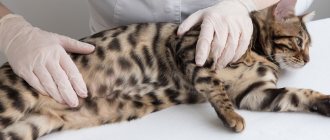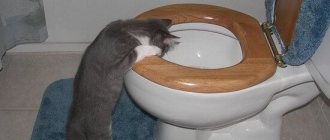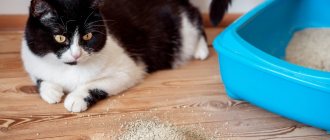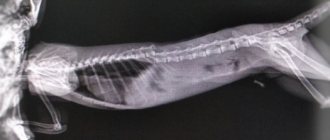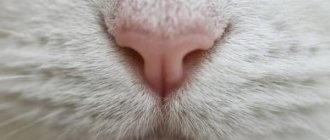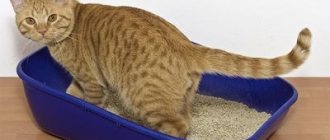Kitten has diarrhea requires slightly different treatment than in adult cats, and besides, the animal’s immune system is not yet formed, which also needs to be taken into account. Do you want to know why kittens get an upset stomach and how to treat this condition? Then be sure to read this article to the end! There is a lot of useful and interesting things for all owners of these furry little balls. Remember that with diarrhea, self-medication is strictly unacceptable.
Diarrhea in a kitten: causes
There are many reasons for diarrhea in kittens Even mild stress can lead to diarrhea, which causes significant discomfort.
- Possible reasons why a kitten has diarrhea:
- Fatty foods, unsuitable food - all this can cause stool upset.
- Cats, as a rule, love to lick themselves; they are quite clean. However, this behavior can lead to parasite infestation.
- These bacteria can also be found in raw meat or fish.
- Diarrhea in a kitten can also be provoked by severe stress, for example, a visit to a veterinary clinic, or moving to a country house or another place of residence.
- Poisoning or eating low-quality food can also cause distress in a one-month-old kitten.
- Long-term treatment with antibiotics also disrupts the animal’s intestinal microflora.
- Feeding raw meat products can cause diarrhea with mucus in a kitten. And salmonella, which is contained in meat products that have not been heat treated, can enter the body. As a rule, such bacteria pose a fairly serious threat to the fragile animal’s body.
- If a kitten has bloody diarrhea, this is a direct threat to the life and health of the animal. Not only does dehydration occur due to blood loss, but the body also loses many useful substances that are washed out through feces.
- Diarrhea can also occur due to a sudden change in climatic conditions. Let's say you decide to relax and take your animal with you on a trip. At such a tender age, you should not allow such stressful situations.
- Changing food can also cause diarrhea and diarrhea. For example, if the breeder fed the baby natural food, then in this case you should not suddenly switch him to drying, no matter how impatient you are. Do it gradually.
However, the true cause of diarrhea cannot always be determined.
. And in this case, you have to deal with such unpleasant symptoms as frequent loose stools and pain in the stomach. The kitten seems to be hunching over, trying to get rid of unpleasant sensations.
Diarrhea in a kitten: color of feces
During an intestinal disorder, you should also pay attention to the color of feces. This will help you find out what actually caused the disorder.
- What color can a kitten have diarrhea and what does it mean:
- The color of the stool is black and even mixed with blood? This can mean a wide variety of serious diseases, such as panleukopenia or enteritis. Such conditions should never be treated without a veterinarian.
- A yellow tint of diarrhea may indicate dysbacteriosis or inflammation of the stomach.
- Green diarrhea with a putrid odor, coupled with fever, may mean the development of putrefactive microflora. In this case, you need to call a doctor at home as soon as possible and not waste precious time searching for information on the request: “The kitten has diarrhea, what should I do?” It is possible that the data may be inaccurate.
When calling a doctor at home, be prepared to inform the dispatcher about the color of the stool. This is very important for making the correct diagnosis, as well as choosing treatment tactics. For a speedy recovery, the owner needs to monitor his pet throughout the day, remembering the consistency of the stool, as well as the pet’s behavior at the moment.
general information
Diarrhea is the rapid “evacuation” of semi-digested contents of the small intestine, accompanied by cramps, intoxication and dehydration. The total amount of feces excreted by the cat increases several times. By the way, if your pet has diarrhea, in what cases is it advisable to call a veterinarian? Frankly speaking, he needs to be called whenever the cat has some kind of “problem” with digestion. The specialist needs to know when and after what they started, and how the cat feels at this time.
It is necessary to urgently consult a doctor in cases where, in addition to feces, the stool contains mucous inclusions, a lot of undigested pieces of food, etc.
Never give your cat “human” medications unless advised by your veterinarian! So you can “easily and naturally” poison your pet!
Is diet important in treating a symptom like diarrhea in a kitten?
Diarrhea in a kitten is a consequence of a disorder of the gastrointestinal tract . In this regard, you simply need a healthy diet with certain restrictions, which will help normalize the functioning of the stomach and intestines as a whole.
- Basic nutrition principlesif the kitten had diarrhea:
- Eliminate fermented milk products from your diet.
- Do not feed from the common table.
- Feed only fresh foods.
- Feed with boiled chicken and rice, you can solder the rice solution, it has a strengthening property.
- To avoid dehydration, you can also give your four-legged friend any medications that will help prevent this. For example, magnesium sulfate or just drinking plenty of fluids.
However, remember that if a kitten has bloody diarrhea , diet alone will not get rid of it. Serious research from professional doctors will be required
. It should be remembered that kittens are weaker than adult animals, and therefore it makes sense to seek medical help as soon as possible.
- There are several reasons why you should definitely contact a veterinarian for help:
- The first argument is competent doctors.
- The second argument is the possibility of a specialist visiting your home, which is very valuable when a kitten at the age of 2 months has diarrhea. A trip to the veterinary center would be unnecessary stress for him, which is now completely unnecessary for the pet.
- The third argument is the professional approach of doctors to their work.
Causes and associated symptoms
The causes of bloody diarrhea in cats are:
- bacterial diseases (for example, salmonellosis);
- viral infections (feline leukemia, “feline distemper”);
- tumors;
- parasites (roundworms, tapeworms);
- foreign bodies;
- change in diet;
- food allergies;
- eating grass;
- food poisoning;
- increased levels of thyroid hormones;
- use of medications;
- toxoplasmosis;
- gastroenteritis.
Bloody diarrhea may be accompanied by vomiting, fever, and lack of appetite. The animal becomes lethargic. The nose is dry and warm to the touch.
Doctors on the staff of “I-VET” to answer why a kitten has diarrhea and in other situations
The veterinary is one of the few in the capital that can boast of having highly specialized specialists. We have the following professionals in our arsenal:
- gastroenterologist;
- dentist;
- gynecologist for dogs and cats;
- ratologist;
- ophthalmologist;
- neurologist;
- nephrologist;
- many other specialists who are ready to help with the most exotic animals that can only exist on our planet.
Such a variety of specialists will allow you to receive first-class assistance at any time. Even if you call us late at night, specialists will arrive promptly, within 40 minutes maximum, and help solve all problems related to your pet’s health as quickly as possible.
Many consider calling a veterinarian to your home a fad for the rich, however, for example, with diarrhea, this can be an invaluable help that will help quickly, easily and safely for others to help your pet.
List of medications for treating diarrhea
There is a list of the most popular medications for the treatment of diarrhea in cats:
- Smecta. A well-established medicine against diarrhea. Smecta can be given to a kitten only in the initial stages of diseases of the digestive system. The dosage of Smecta should be selected based on the weight and age of the pet.
- Polysorb is also good.
- Most often, veterinarians prescribe Phthalazol.
- Activated carbon. It is allowed if the animal only has diarrhea without additional symptoms.
- When using Loperamide, the dose should be the minimum. Tablets are not the most suitable medication for cats. It should be given with great caution.
- Enterosgel for kittens against diarrhea is approved; it helps cleanse the body.
- Antibiotics are prescribed only as prescribed by a doctor.
- Enterofuril for kittens with diarrhea is able to cope with the disease in the shortest possible time.
- Furazolidone is prescribed for kittens for diarrhea without a veterinarian's prescription.
- Bifidumbacterin is prescribed for such ailments quite often.
- Levomycetin should always be in your home medicine cabinet in case of diarrhea.
In addition to the above-mentioned medications, cats are additionally prescribed probiotics.
Treatment at home
You should treat your cat yourself only if the signs of the disease do not cause concern for the health and life of the baby. Regular activated charcoal can be given as a simple treatment for diarrhea. In addition, folk remedies can also stop diarrhea.
In what cases is the help of a veterinarian necessary?
It happens that treatment of diarrhea does not give the desired result or there are additional elements in the discharge, and the pet’s condition has worsened. It is worth taking the cat to the veterinarian to avoid further harm to the animal.
If results after home treatment do not appear the next day, you should go to the veterinarian. If necessary, the baby is given a blood test.
Diarrhea in a kitten: what to do before the doctor arrives
- First of all, do not give your kitten serious medications, for example, painkillers, which can only disrupt the overall picture of the disease.
- Do not disturb the kitten or play with it against its will. Be extremely careful with him.
- Clearly explain to your household that it is better to leave the animal alone, it is already unwell.
- Do not give forbidden food, no matter how the kitten asks, however, it is quite possible that he will not have an appetite at the moment.
- Since veterinary care will be provided at home, you should be prepared for different situations and prepare the premises for the doctor's arrival.
- The doctor knows better what tests and procedures should be done. Therefore, the owner is recommended to know the address of the nearest pharmacy, both human and for animals, where he can buy all the necessary things and medicines.
How to help a kitten at home
Proper first aid is very important to avoid further harm to your pet:
- We place the kitten in a calm, warm place.
- We do not feed under any circumstances, even if there is an appetite.
- It is allowed to give water if the animal drinks on its own.
- We do not give any medications without consulting a veterinarian.
- We collect stool for laboratory analysis - this will help significantly speed up diagnosis.
- We take the animal to the clinic - the sooner the better.
Blood in the stool (medical: hematochezia, melena) is seen by most patients as something terrible. If you notice blood in your stool, you don’t have to worry about the worst, but you should immediately consult a doctor. Possible causes of blood in the stool include gastrointestinal infections, colon polyps or hemorrhoids, stomach ulcers or chronic inflammatory disease of the large intestine. To exclude the diagnosis of malignant diseases - such as intestinal cancer - it is necessary to immediately conduct appropriate research in the clinic. Below you will learn all the important information about the “blood in the stool” symptom.
Blood in the stool: Description
Blood in the stool indicates that the body is losing blood somewhere inside the gastrointestinal tract, which is then found mixed in the stool. The color and consistency of mixed blood can serve as an almost reliable indication of where the source of bleeding is located.
Blood in stool does not necessarily appear as a bright red or dark red coating or impurity; in fact, it can turn the stool black. The corresponding manifestations depend on the level of bleeding in the digestive tract, since the state of the blood changes upon contact with gastric juice and as a result of processing by microorganisms.
Red blood in the stool (hematochezia)
If the blood in the stool is bright red or dark red, in the form of impurities or streaks, then the blood is relatively fresh. This type of blood in the stool is called hematochezia. The source of bleeding is most likely in the middle or lower parts of the gastrointestinal tract (GIT), because the blood could not be destroyed in large quantities either by the hydrochloric acid of the stomach or by bacteria.
If the stool is uniformly dark red, this may indicate, for example, major bleeding in the large intestine. With minor bleeding, jelly-like traces of blood are observed in the stool.
In turn, light red stripes may indicate fresh bleeding in the rectal area, for example, with hemorrhoids.
Black blood in stool (melena, tarry stool)
If the stool is black and shiny, then we are talking about the so-called tarry stool (melena). When bleeding in the upper gastrointestinal tract, that is, from the esophagus to the duodenum, hemoglobin in the blood breaks down into hematin upon contact with gastric juice. This hematin is the cause of black stools, and in cases of vomiting, the vomit may resemble coffee grounds.
Black stool most often indicates that the source of the bleeding is higher than the small intestine and is caused by either a stomach ulcer or bleeding in the esophagus.
Since intestinal bacteria, with prolonged contact with blood, also cause the breakdown of hemoglobin into the pigment hematin, black stool may not necessarily be a consequence of bleeding in the upper gastrointestinal tract. When the passage of chyme (intestinal contents) is slow, melena can be caused by bleeding located deeper.
Under certain circumstances, high-lying bleeding in the gastrointestinal tract, on the contrary, can lead to hematochezia, both when the secretion of gastric juice decreases due to medication, and in case of severe bleeding, when chyme quickly passes through the intestines.
Hidden blood in stool
It may also be that although there is blood in the stool, it is not visible. Then we are talking about hidden blood. In most cases, it is discovered incidentally during a routine examination or during a targeted examination of known damage to the digestive tract.
Since blood cannot be detected with the naked eye, a guaiacol test for detecting blood in stool (hemoccult test) is used, which can detect even small quantities.
Cases that are confused with the presence of blood in the stool
After eating certain foods, your stool may look like there is blood in it. This is caused by the consumption of red beets, which stain the stool dark red, which occurs with hematochezia. Blueberries turn the stool black, similar to licorice, so that when examined, it is perceived as melena.
Also, some medications can cause black stool (for example, activated charcoal or iron supplements).
Blood in the stool: Causes and possible diseases:
Various possible reasons for the appearance of blood in the stool, causing bleeding in the gastrointestinal tract, are being considered. These include bleeding from the oropharynx, esophagus, stomach, small and large intestines and anus. In principle, bleeding can occur in every department, with the frequency and significance of different causes varying.
Blood in the stool due to bleeding in the upper digestive tract
- The most common cause of bleeding in the upper digestive tract is ulcers in the stomach and duodenum, often caused by Helicobacter pylori bacteria or long-term use of certain medications, such as aspirin.
- Chronic heartburn can, when gastric juice gets in, lead to inflammation of the esophagus (reflux esophagitis) and, as a result, bleeding.
- With certain liver diseases, a redistribution of venous blood flow occurs, which causes varicose veins of the esophagus. Such dilated veins easily rupture and lead to severe, often life-threatening bleeding.
- After profuse vomiting, extended tears of the mucous membrane may occur at the junction of the esophagus and the stomach. Then we are talking about Mallory-Weiss syndrome, often found in alcoholics who have previously had damaged mucous membranes.
- Finally, blood in the stool can also be a likely symptom of stomach cancer.
- In the middle sections of the digestive tract, the most common cause of bleeding is tumors of the small intestine. Also in the large intestine, atypical growths can lead to the appearance of blood in the stool. They do not have to be malignant.
- Particularly in young patients, chronic inflammatory bowel diseases such as Crohn's disease or ulcerative colitis can cause bleeding. If in the latter case only the colon and rectum are affected, then in Crohn's disease the entire gastrointestinal tract [can] be affected. The exact causes of both diseases are unknown.
- Polyps are most often benign growths of the large intestine that usually do not cause any problems, but as their size increases, the risk of bleeding also increases. They can also develop into pre-cancerous conditions, so after a certain size they are mostly removed. The consequence of such interventions, in turn, may be secondary bleeding.
- With diverticula, we are talking about protrusions of the walls of the intestinal wall, which, when viewed from the inside, are small “pits”. Diverticula most often form and are found in the large intestine. Depending on the circumstances, they can become inflamed (then we are talking about diverticulitis) and cause bleeding.
- Various intestinal infectious diseases, ranging from common gastroenteritis to severe diseases such as typhus or dysentery, can cause blood in the stool, most often in combination with diarrhea. Also, excessive proliferation of bacteria that make up the natural intestinal microflora, for example, after [a course of] antibiotic therapy, can cause hematochezia. An example is pseudomembranous colitis.
- Bright red blood in the stool often occurs with hemorrhoids. This usually refers to a pathological increase in arteriovenous anastomoses under the rectal mucosa. During defecation, they are often damaged, resulting in a coating of fresh, often bright red blood.
- Elderly people often experience so-called mesenteric infarctions, that is, blockage of intestinal vessels. If the tissues of the affected areas are damaged, subsequent bleeding may occur.
Blood in the stool due to bleeding in the middle and lower parts of the digestive tract
Blood in the stool: When should you see a doctor?
If you find blood in your stool, you should consult a doctor in any case. Despite the fact that most bleeding stops on its own without medical help and is often not dangerous. It is still necessary to find out where the source of the bleeding is and whether there is a more serious disease behind it. Especially if you have other symptoms, such as:
- Pain in the stomach and abdomen.
- Pain during bowel movements.
- Nausea and vomiting (including in the presence of blood in the vomit).
- Prolonged lethargy and fatigue.
- Pronounced weight loss in a short time.
- Night sweats.
You can't put off visiting a doctor.
If there is severe bleeding in the digestive tract after a certain period of time, anemia (anemia) may occur due to blood loss, which in any case requires treatment.
Blood in the stool: What does the doctor do?
If blood in the stool is caused by acute bleeding in the gastrointestinal tract, resulting in severe blood loss, it is necessary first of all to replace the missing blood volume. If left untreated, in worst cases it can lead to spinolaemic shock, a life-threatening condition.
The patient is placed in a supine position, receives oxygen through a nasal tube and, as soon as possible, a blood substitute to replenish lost blood volumes. In case of large blood losses, blood transfusions are also performed.
Also, with chronic bleeding in the gastrointestinal tract over a long period of time, anemia may develop, the treatment of which is similar [to the treatment of acute blood loss].
History and investigations
If a patient consults a doctor complaining of blood in the stool, in most cases the location of the bleeding is unknown and must be determined.
Medical history data can provide valuable guidance. For example, it may be important whether there has been blood in the stool before. It should also be clarified whether there were previously hemorrhoids, peptic ulcers, chronic inflammatory bowel diseases, alcohol abuse or diverticula, that is, whether there are risk factors for gastrointestinal bleeding. Next, studies are carried out to detect the source of bleeding.
- Of great importance in this case is gastroendoscopy, in which a gastric tube (gastroenteroscope) is inserted through the mouth and allows the doctor to assess the condition of the esophagus, stomach and duodenum using an endoscope. When examining the large intestine (coloscopy), the endoscope is inserted into the rectum and can be inserted down to the final part of the small intestine. Using these examination methods, many possible causes can be detected, such as diverticulum, chronic inflammation, ulcers, esophageal varices, colon polyps and other growths. Rectoscopy is most often used to examine hemorrhoids. Although the nature of the blood in the stool, as well as possible previously established diseases, can indicate the location of the source of bleeding, it is still better to use gastroduodenoscopy, especially in cases where the specific lesion cannot be identified.
Since gastroduodenoscopy cannot always determine the source of bleeding and, in addition, it is not always possible to obtain sufficient data, in such cases additional research methods are used.
- Double-balloon enteroscopy allows you to examine the condition of the small intestine. In this case, two balloons attached to the endoscope are alternately inflated so that they can be advanced along the length of the endoscope. This study is usually carried out in two stages - examination of the upper part of the small intestine with insertion of a probe through the mouth, and the lower part through the anus.
- Meanwhile, it is also possible to perform video capsule endoscopy. In this case, the patient swallows a mini-camera, which takes pictures at certain intervals. This way the small intestine is examined. However, this method takes time and does not allow precise localization of the source of bleeding.
- Ultrasound can help identify blockages in blood vessels as a possible cause of blood in the stool.
- Further, nuclear medicine techniques and selective arteriography can be used, which can detect only active bleeding.
- If it is suspected that the cause of blood in the stool is an infection, an attempt is made to identify the corresponding pathogen using stool and blood cultures.
Therapeutic measures
Treatment depends on the cause of the bleeding. First of all, you should, of course, stop active bleeding, then you need to prevent recurrent bleeding by fighting the cause.
In order to stop active bleeding in the digestive tract, various endoscopic techniques are first used. It is advisable that if the source of bleeding is detected during gastro- or colonoscopy, the cause of the bleeding can also be eliminated using one of the following methods:
- bleeding can be stopped, for example, with a hemoclip - a type of clamp that compresses the affected area.
- There are also injection techniques, in which a solution of adrenaline is injected into the site of bleeding with a needle, which compresses the blood vessels, or so-called fibrin glue can be injected.
- It is possible to use a laser to cauterize the bleeding site.
- The source of bleeding can be cut out microsurgically.
- In the case of esophageal varices and hemorrhoids, latex ligation is often used.
When the bleeding has stopped, treatment begins to eliminate the cause of the disease:
- For peptic ulcers, an attempt is made to reduce the production of stomach acid with the help of certain medications (proton pump inhibitors, PPIs), and dietary therapy can also be carried out. In case of Helicobacter pylori , a combination of various antibiotics is used.
- The cause of varicose nodes in the esophagus is high pressure in the portal vein system, and therefore they try to reduce it with the help of medications (beta blockers, spironolactone).
- Chronic inflammatory bowel diseases require special treatment, using anti-inflammatory drugs - glucocorticoids.
- Diverticulitis is treated with antibiotics. If this is no longer possible, the affected area of the intestine is removed.
- Intestinal polyps are also usually removed.
- For malignant diseases, surgery, chemotherapy and radiation therapy are considered.
How to contact us
Email: Tel.: +49 212 5476913 Viber | WhatsApp: +49 173-2034066 | +49 177-5404270 For your convenience, please save the phone number in your phone book and call or write to us for free on WhatsApp, Viber or Telegram. Applications made on weekends or holidays will be processed on the first business day.
Entry of foreign bodies into the body
Small inedible objects that a cat swallows while playing or eating often cause indigestion for the animal. Such objects can be different in shape, size and structure.
When a foreign body enters the pet’s intestines, malaise manifests itself through refusal to eat, repeated vomiting, bowel problems in the form of constipation or diarrhea, lethargy, irritability when touched or stroking the abdomen. If a foreign object does not leave the body naturally and remains there for more than a day, inflammation develops, as a result of which intestinal motility is disrupted, tissue necrosis and perforation of the mucous membranes, and septic processes begin. In this case, only surgical intervention can help a sick animal. It should be borne in mind that the manifestation of all the above symptoms is not always complex. This means that even only one of them can arise. With partial intestinal blockage, the cat can maintain normal physical activity, a healthy appetite and bowel movements. If at least one of the alarming symptoms still makes itself felt, you should show the animal to a veterinarian.
Helminth infections or helminthic infestations - and frequent loose stools in a cat
The causative agents of diseases called helminth infections are parasitic worms. They remain viable and adapt to existence in the body of both animals and humans. Worm eggs enter a cat's body through raw meat, dirty water, through the surface of unwashed vegetables and fruits, grass, through the air and through hair when licked. Even if the animal is kept in a house or apartment and does not walk outside, the likelihood of infection remains quite high. Helminth eggs can get to the animal from shoes, clothes or dirty hands of an owner who regularly leaves the house.
Manifestations of helminthic disease differ depending on the type of pathogen. At the same time, there are universal signs that indicate any helminthic activity: lethargy, weakness, diarrhea, dull hair, tight sensitive stomach, unpleasant odor from the mouth. Due to itching in the anus, the cat often licks and scratches it. The pet refuses food or eats it with great appetite and greed without chewing, digestive problems begin and the animal loses weight.
Parasites that settle in the body of cats are divided into three types: round tapeworms, tapeworms and flukes. To select the most effective drug suitable for a specific case of disease, it is necessary to examine the animal by seeking help from a veterinarian.
What to feed a kitten with diarrhea
A hunger strike is a hunger strike, but you still need to feed the baby something. After a 12-hour break in nutrition, you need to start giving the baby food. If the kitten is small and very weak, you will have to feed it with a pipette or from a bottle.
The main task will be to prevent dehydration!
The transition to a normal diet (healthy!) is carried out gradually: you need low-calorie, low-fat food. It will be possible to feed the cat chicken broth, kefir, boiled eggs, rice porridge, and minced chicken, but not all at once on the same day.
If the condition worsens, the animal is taken to a doctor. If recovery is noticeable, then kefir is included in the diet. The diet is not changed for a while, only gradually adding other foods. Milk is completely excluded, as is fried, smoked, and fatty milk.
Toxoplasmosis as a cause of bloody diarrhea in cats
The causative agent of this infectious disease is Toxoplasma godini, a parasitic microorganism. The initial hosts of the parasite are feline mammals, from which it can be transmitted to other animals, birds and people. Toxoplasmosis enters the body of cats by consuming raw, contaminated meat from rodents and livestock. After several weeks, the causative agent of the disease enters the external environment in the animal’s feces. Human infection occurs through the fecal-oral route. At the same time, the disease is transmitted between people only in utero, that is, from mother to gestating fetus; it is impossible to become infected through personal hygiene items or common use.
Externally, toxoplasmosis in cats manifests itself in the same way as a cold or diarrhea. At the initial stage, the disease in the animal is expressed through apathy and lack of appetite. Then diarrhea and vomiting begin. When these symptoms pass, the malaise becomes latent. In severe cases, the animal develops a fever, purulent discharge from the eyes begins, and blood inclusions are visible in the stool. The cat sneezes, coughs, suffers from wheezing and shortness of breath. The acute form of toxoplasmosis has a detrimental effect on all cells of the body. Necrosis forms at the affected sites. The outcome depends on the timeliness of detection of the disease and the level of effectiveness of the therapy performed.
